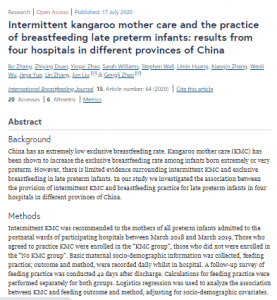
Background
China has an extremely low exclusive breastfeeding rate. Kangaroo mother care (KMC) has been shown to increase the exclusive breastfeeding rate among infants born extremely or very preterm. However, there is limited evidence surrounding intermittent KMC and exclusive breastfeeding in late preterm infants. In our study we investigated the association between the provision of intermittent KMC and breastfeeding practice for late preterm infants in four hospitals in different provinces of China.
Methods
Intermittent KMC was recommended to the mothers of all preterm infants admitted to the postnatal wards of participating hospitals between March 2018 and March 2019. Those who agreed to practice KMC were enrolled in the “KMC group”, those who did not were enrolled in the “No KMC group”. Basic maternal sociodemographic information was collected, feeding practice; outcome and method, were recorded daily whilst in hospital. A follow-up survey of feeding practice was conducted 42 days after discharge. Calculations for feeding practice were performed separately for both groups. Logistics regression was used to analyze the association between KMC and feeding outcome and method, adjusting for socio-demographic covariates.
Results
Among the 844 mothers participating in the study, 627 (74.3%) chose to perform KMC. More of the mothers who provided KMC were exclusively breast milk feeding their infants in the 24 h before hospital discharge (54.6%) and at follow-up (57.3%), compared to mothers who did not provide KMC (34.6% at discharge and 33.2% at follow-up,). Mothers in the KMC group were more likely to be breastfeeding (method) than mothers in the No KMC group (65.3% vs. 52.1% at discharge, and 83.1% vs. 67.3% at follow up). Logistic regression indicated that compared with the No KMC group, mothers who provided KMC were twice as likely to be exclusively breast milk feeding their infants at discharge (OR = 2.15 (95% CI 1.53, 3.02)), use breastfeeding method at discharge as opposed to other means such as bottle or cup feeding (OR = 1.61 (95% CI 1.15, 2.25)), be exclusive breast milk feeding at follow-up (OR = 2.55 (95% CI 1.81, 3.61)), and use breastfeeding method at follow-up (OR = 2.09 (95% CI 1.44, 3.02)).